Yonatan Bisk
Casper: Inferring Diverse Intents for Assistive Teleoperation with Vision Language Models
Jun 17, 2025Abstract:Assistive teleoperation, where control is shared between a human and a robot, enables efficient and intuitive human-robot collaboration in diverse and unstructured environments. A central challenge in real-world assistive teleoperation is for the robot to infer a wide range of human intentions from user control inputs and to assist users with correct actions. Existing methods are either confined to simple, predefined scenarios or restricted to task-specific data distributions at training, limiting their support for real-world assistance. We introduce Casper, an assistive teleoperation system that leverages commonsense knowledge embedded in pre-trained visual language models (VLMs) for real-time intent inference and flexible skill execution. Casper incorporates an open-world perception module for a generalized understanding of novel objects and scenes, a VLM-powered intent inference mechanism that leverages commonsense reasoning to interpret snippets of teleoperated user input, and a skill library that expands the scope of prior assistive teleoperation systems to support diverse, long-horizon mobile manipulation tasks. Extensive empirical evaluation, including human studies and system ablations, demonstrates that Casper improves task performance, reduces human cognitive load, and achieves higher user satisfaction than direct teleoperation and assistive teleoperation baselines.
FieldWorkArena: Agentic AI Benchmark for Real Field Work Tasks
May 26, 2025Abstract:This paper proposes FieldWorkArena, a benchmark for agentic AI targeting real-world field work. With the recent increase in demand for agentic AI, they are required to monitor and report safety and health incidents, as well as manufacturing-related incidents, that may occur in real-world work environments. Existing agentic AI benchmarks have been limited to evaluating web tasks and are insufficient for evaluating agents in real-world work environments, where complexity increases significantly. In this paper, we define a new action space that agentic AI should possess for real world work environment benchmarks and improve the evaluation function from previous methods to assess the performance of agentic AI in diverse real-world tasks. The dataset consists of videos captured on-site and documents actually used in factories and warehouses, and tasks were created based on interviews with on-site workers and managers. Evaluation results confirmed that performance evaluation considering the characteristics of Multimodal LLM (MLLM) such as GPT-4o is feasible. Additionally, the effectiveness and limitations of the proposed new evaluation method were identified. The complete dataset (HuggingFace) and evaluation program (GitHub) can be downloaded from the following website: https://en-documents.research.global.fujitsu.com/fieldworkarena/.
Energy Considerations of Large Language Model Inference and Efficiency Optimizations
Apr 24, 2025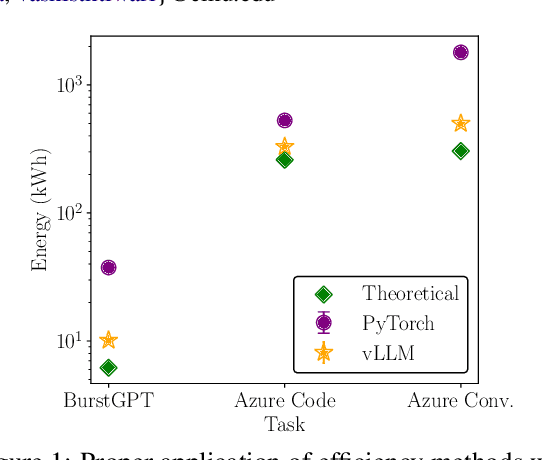



Abstract:As large language models (LLMs) scale in size and adoption, their computational and environmental costs continue to rise. Prior benchmarking efforts have primarily focused on latency reduction in idealized settings, often overlooking the diverse real-world inference workloads that shape energy use. In this work, we systematically analyze the energy implications of common inference efficiency optimizations across diverse Natural Language Processing (NLP) and generative Artificial Intelligence (AI) workloads, including conversational AI and code generation. We introduce a modeling approach that approximates real-world LLM workflows through a binning strategy for input-output token distributions and batch size variations. Our empirical analysis spans software frameworks, decoding strategies, GPU architectures, online and offline serving settings, and model parallelism configurations. We show that the effectiveness of inference optimizations is highly sensitive to workload geometry, software stack, and hardware accelerators, demonstrating that naive energy estimates based on FLOPs or theoretical GPU utilization significantly underestimate real-world energy consumption. Our findings reveal that the proper application of relevant inference efficiency optimizations can reduce total energy use by up to 73% from unoptimized baselines. These insights provide a foundation for sustainable LLM deployment and inform energy-efficient design strategies for future AI infrastructure.
Looking beyond the next token
Apr 15, 2025Abstract:The structure of causal language model training assumes that each token can be accurately predicted from the previous context. This contrasts with humans' natural writing and reasoning process, where goals are typically known before the exact argument or phrasings. While this mismatch has been well studied in the literature, the working assumption has been that architectural changes are needed to address this mismatch. We argue that rearranging and processing the training data sequences can allow models to more accurately imitate the true data-generating process, and does not require any other changes to the architecture or training infrastructure. We demonstrate that this technique, Trelawney, and the inference algorithms derived from it allow us to improve performance on several key benchmarks that span planning, algorithmic reasoning, and story generation tasks. Finally, our method naturally enables the generation of long-term goals at no additional cost. We investigate how using the model's goal-generation capability can further improve planning and reasoning. Additionally, we believe Trelawney could potentially open doors to new capabilities beyond the current language modeling paradigm.
Re-thinking Temporal Search for Long-Form Video Understanding
Apr 03, 2025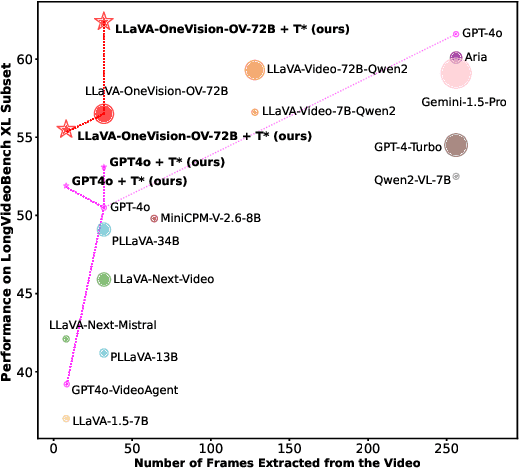
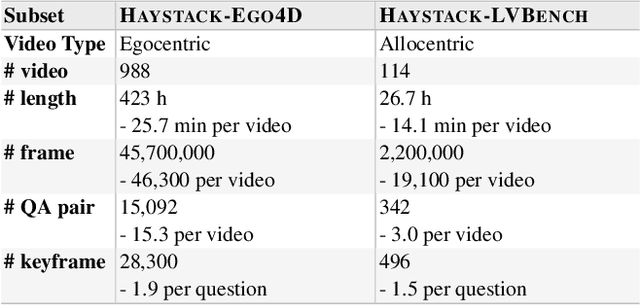
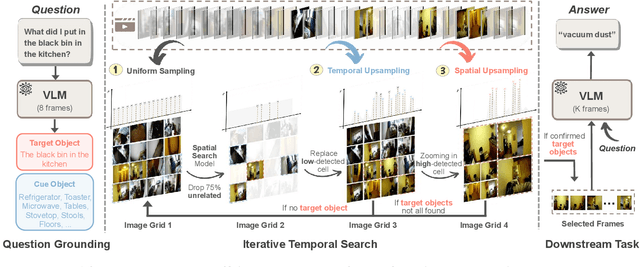
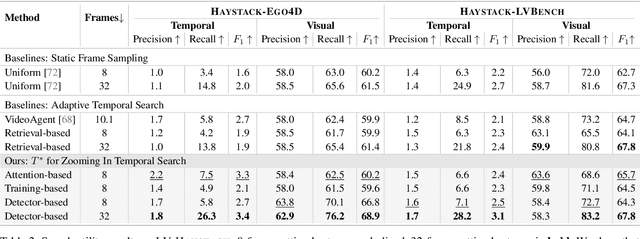
Abstract:Efficient understanding of long-form videos remains a significant challenge in computer vision. In this work, we revisit temporal search paradigms for long-form video understanding, studying a fundamental issue pertaining to all state-of-the-art (SOTA) long-context vision-language models (VLMs). In particular, our contributions are two-fold: First, we formulate temporal search as a Long Video Haystack problem, i.e., finding a minimal set of relevant frames (typically one to five) among tens of thousands of frames from real-world long videos given specific queries. To validate our formulation, we create LV-Haystack, the first benchmark containing 3,874 human-annotated instances with fine-grained evaluation metrics for assessing keyframe search quality and computational efficiency. Experimental results on LV-Haystack highlight a significant research gap in temporal search capabilities, with SOTA keyframe selection methods achieving only 2.1% temporal F1 score on the LVBench subset. Next, inspired by visual search in images, we re-think temporal searching and propose a lightweight keyframe searching framework, T*, which casts the expensive temporal search as a spatial search problem. T* leverages superior visual localization capabilities typically used in images and introduces an adaptive zooming-in mechanism that operates across both temporal and spatial dimensions. Our extensive experiments show that when integrated with existing methods, T* significantly improves SOTA long-form video understanding performance. Specifically, under an inference budget of 32 frames, T* improves GPT-4o's performance from 50.5% to 53.1% and LLaVA-OneVision-72B's performance from 56.5% to 62.4% on LongVideoBench XL subset. Our PyTorch code, benchmark dataset and models are included in the Supplementary material.
Self-Regulation and Requesting Interventions
Feb 07, 2025



Abstract:Human intelligence involves metacognitive abilities like self-regulation, recognizing limitations, and seeking assistance only when needed. While LLM Agents excel in many domains, they often lack this awareness. Overconfident agents risk catastrophic failures, while those that seek help excessively hinder efficiency. A key challenge is enabling agents with a limited intervention budget $C$ is to decide when to request assistance. In this paper, we propose an offline framework that trains a "helper" policy to request interventions, such as more powerful models or test-time compute, by combining LLM-based process reward models (PRMs) with tabular reinforcement learning. Using state transitions collected offline, we score optimal intervention timing with PRMs and train the helper model on these labeled trajectories. This offline approach significantly reduces costly intervention calls during training. Furthermore, the integration of PRMs with tabular RL enhances robustness to off-policy data while avoiding the inefficiencies of deep RL. We empirically find that our method delivers optimal helper behavior.
Explore Theory of Mind: Program-guided adversarial data generation for theory of mind reasoning
Dec 12, 2024



Abstract:Do large language models (LLMs) have theory of mind? A plethora of papers and benchmarks have been introduced to evaluate if current models have been able to develop this key ability of social intelligence. However, all rely on limited datasets with simple patterns that can potentially lead to problematic blind spots in evaluation and an overestimation of model capabilities. We introduce ExploreToM, the first framework to allow large-scale generation of diverse and challenging theory of mind data for robust training and evaluation. Our approach leverages an A* search over a custom domain-specific language to produce complex story structures and novel, diverse, yet plausible scenarios to stress test the limits of LLMs. Our evaluation reveals that state-of-the-art LLMs, such as Llama-3.1-70B and GPT-4o, show accuracies as low as 0% and 9% on ExploreToM-generated data, highlighting the need for more robust theory of mind evaluation. As our generations are a conceptual superset of prior work, fine-tuning on our data yields a 27-point accuracy improvement on the classic ToMi benchmark (Le et al., 2019). ExploreToM also enables uncovering underlying skills and factors missing for models to show theory of mind, such as unreliable state tracking or data imbalances, which may contribute to models' poor performance on benchmarks.
Hardware Scaling Trends and Diminishing Returns in Large-Scale Distributed Training
Nov 20, 2024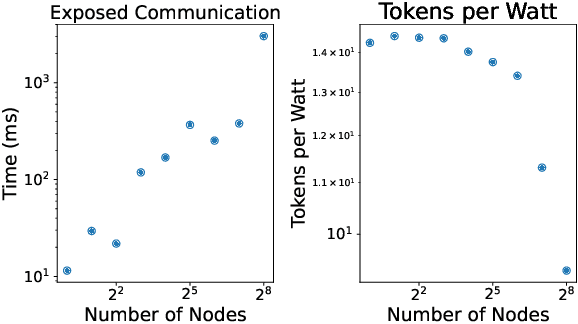

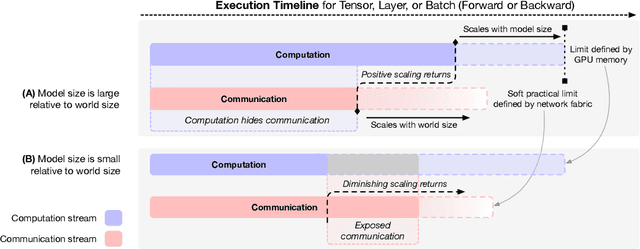
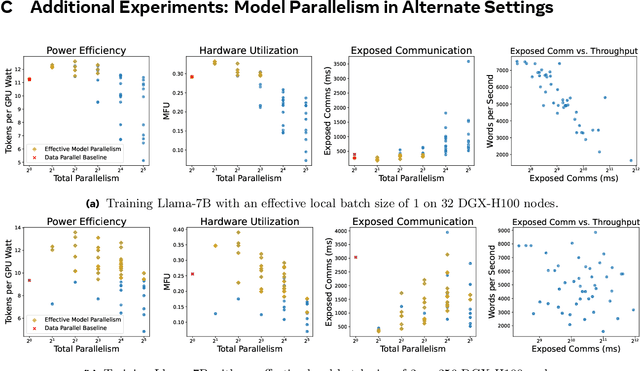
Abstract:Dramatic increases in the capabilities of neural network models in recent years are driven by scaling model size, training data, and corresponding computational resources. To develop the exceedingly large networks required in modern applications, such as large language models (LLMs), model training is distributed across tens of thousands of hardware accelerators (e.g. GPUs), requiring orchestration of computation and communication across large computing clusters. In this work, we demonstrate that careful consideration of hardware configuration and parallelization strategy is critical for effective (i.e. compute- and cost-efficient) scaling of model size, training data, and total computation. We conduct an extensive empirical study of the performance of large-scale LLM training workloads across model size, hardware configurations, and distributed parallelization strategies. We demonstrate that: (1) beyond certain scales, overhead incurred from certain distributed communication strategies leads parallelization strategies previously thought to be sub-optimal in fact become preferable; and (2) scaling the total number of accelerators for large model training quickly yields diminishing returns even when hardware and parallelization strategies are properly optimized, implying poor marginal performance per additional unit of power or GPU-hour.
Gradient Localization Improves Lifelong Pretraining of Language Models
Nov 07, 2024Abstract:Large Language Models (LLMs) trained on web-scale text corpora have been shown to capture world knowledge in their parameters. However, the mechanism by which language models store different types of knowledge is poorly understood. In this work, we examine two types of knowledge relating to temporally sensitive entities and demonstrate that each type is localized to different sets of parameters within the LLMs. We hypothesize that the lack of consideration of the locality of knowledge in existing continual learning methods contributes to both: the failed uptake of new information, and catastrophic forgetting of previously learned information. We observe that sequences containing references to updated and newly mentioned entities exhibit larger gradient norms in a subset of layers. We demonstrate that targeting parameter updates to these relevant layers can improve the performance of continually pretraining on language containing temporal drift.
ANAVI: Audio Noise Awareness using Visuals of Indoor environments for NAVIgation
Oct 24, 2024



Abstract:We propose Audio Noise Awareness using Visuals of Indoors for NAVIgation for quieter robot path planning. While humans are naturally aware of the noise they make and its impact on those around them, robots currently lack this awareness. A key challenge in achieving audio awareness for robots is estimating how loud will the robot's actions be at a listener's location? Since sound depends upon the geometry and material composition of rooms, we train the robot to passively perceive loudness using visual observations of indoor environments. To this end, we generate data on how loud an 'impulse' sounds at different listener locations in simulated homes, and train our Acoustic Noise Predictor (ANP). Next, we collect acoustic profiles corresponding to different actions for navigation. Unifying ANP with action acoustics, we demonstrate experiments with wheeled (Hello Robot Stretch) and legged (Unitree Go2) robots so that these robots adhere to the noise constraints of the environment. See code and data at https://anavi-corl24.github.io/
 Add to Chrome
Add to Chrome Add to Firefox
Add to Firefox Add to Edge
Add to Edge